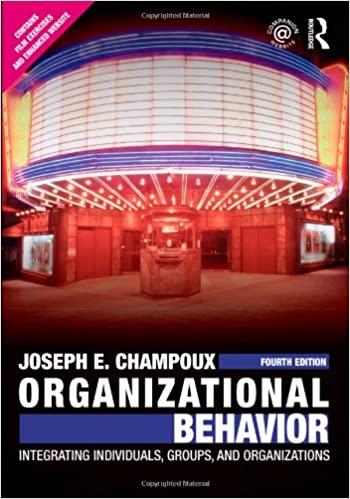Discuss goal-setting theory and its several steps for setting goals. Would you expect such activities to have
Question:
Discuss goal-setting theory and its several steps for setting goals. Would you expect such activities to have a positive effect on your work performance?
GOAL-SETTING THEORY
Edwin A. Locke and his colleagues spent many years studying the effects of goals on human behavior and performance. Their research led to the development and continued testing of goal-setting theory. Empirical research from diverse sources strongly supports the theory.
Goals that are specific, challenging, reachable, and accepted by a person lead to higher performance than goals that are fuzzy, unchallenging, not reachable, or not accepted. Goal specificity includes what needs to be done, how much needs to be done, and the performance period. High performance is partly the result of clear expectations about what to do and when. People told to “do their best” do not perform as well as those who have specific task goals to reach. Goal setting affects behavior through the psychological processes of directing attention, stimulating effort, persisting in the effort, and finding ways to do the task well.
Acceptance of the goal is important, but how one gets acceptance is unimportant. People do about the same, whether goals are set unilaterally by supervisors or are set jointly by themselves and their supervisors. Some research suggests that participation in goal setting is important when employees have high task involvement. Participation increases information about the way a goal can be reached. The information can let employees discover better ways of doing the job.
People also need feedback about their performance and rewards while they are performing. Goal setting without feedback is not effective in improving performance.
Monetary rewards while working toward a goal can result in higher goal commitment and then increased performance. Some evidence exists, however, that using rewards with difficult goals decreases commitment and then performance.
Goal-setting theory recommends the following steps to set goals:
1. Specify the employee’s tasks, duties, and responsibilities.
2. Specify how the employee’s performance will be assessed. Be specific about the way job performance will be assessed and the behaviors that will be part of the assessment.
3. Specify the goal or target to reach. If employee performance can be quantified, then a specific amount of output can be stated. If performance cannot be quantified, then the goal or target should be specified clearly. The goal must be clear and high enough to be challenging, but not so high as to be unreachable.
4. Specify the time span of employee performance. Here the employee learns about deadlines, the time within which the employee must reach the goal. That time can be short or long—one week, one month, or two years, for example.
5. Set priorities among goals. When several goals are set, distinguish the more important goals from the less important. A simple ranking of goals tells the employee which are the most important.
6. Specify goal difficulty and goal priority. If goals vary in difficulty of achievement, then reaching all or part of a difficult goal is a better performance than reaching a simple goal. Achieving goals of low priority is not as high a performance level as achieving goals of high priority. Making distinctions at this step lets both the employee and the supervisor understand variations in goal difficulty and importance.
7. Review goals for coordination and cooperation with others. If an employee’s goals cannot be reached without the cooperation of others, then the goals of many employees might have to be coordinated. This step is necessary to reduce conflict among goals in situations where employees are interdependent.
The goal-setting steps can produce goals that are specific about the task and the time to finish the task. Stating how performance will be measured and stating the priorities among multiple goals make the task even more specific. The challenge of the goal follows from its degree of difficulty.
Goal-setting theory does not view goals as static. Goals often are based on the past and some predictions about the future. As circumstances change, goals might need to change. An important element is the ability to change goals after they have been set because the circumstances surrounding employee performance have changed. For example, a sales quota can be set for a salesperson based on a prediction about the economy over a one-year period. If economic conditions change sharply, the sales quota should also be changed. If the goal is not adjusted downward when the economy turns down, the goal becomes unreachable and employee performance will drop. If the economy turns up and
the goal is not revised upward, the goal becomes too easy and the employee will not perform up to her capabilities.
The supervisor and the organization play important roles in goal accomplishment. The organization should train employees to increase their skills and let them reach increasingly more difficult goals. Management must also provide resources such as money, equipment, and time to get the job done. Lastly, it is especially critical that employees know how well they are doing while trying to reach a goal.
There are some connections between goal-setting and expectancy theory discussed earlier. The effort–performance expectancy increases because of employee training and resources. Feedback and rewards for performance enhance the performance–outcome expectancy. If goals are sufficiently challenging, intrinsic outcomes also should result. The elements of goal-setting theory and the steps in setting goals should all contribute directly to improved employee motivation.
Step by Step Answer:

Organizational Behavior Integrating Individuals Groups And Organizations
ISBN: 9780415804646
4th Edition
Authors: Joseph E. Champoux





